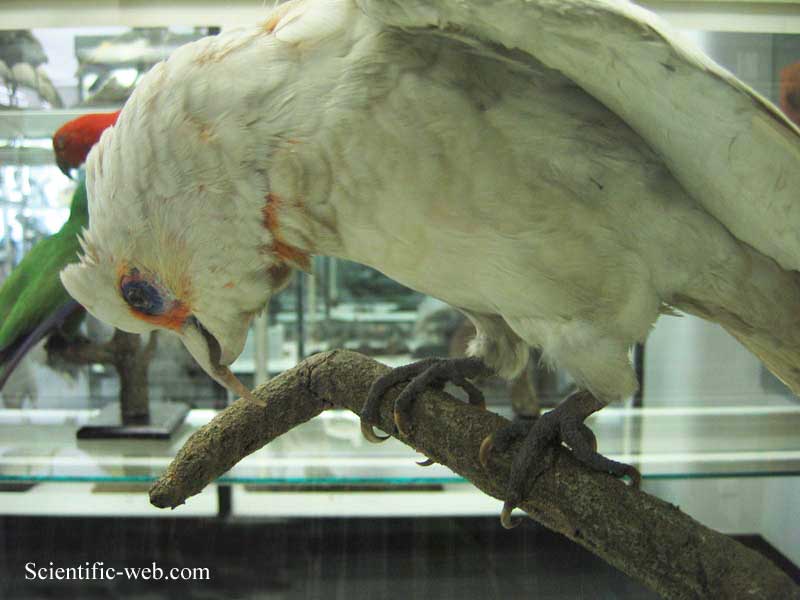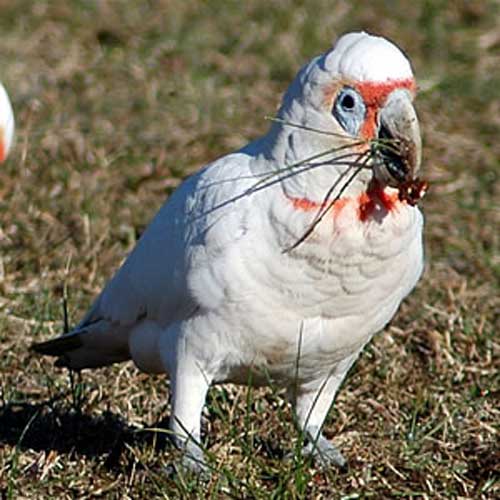
Cacatua tenuirostris , Photo: Michael Lahanas
Superregnum: Eukaryota
Cladus: Unikonta
Cladus: Opisthokonta
Cladus: Holozoa
Regnum: Animalia
Subregnum: Eumetazoa
Cladus: Bilateria
Cladus: Nephrozoa
Superphylum: Deuterostomia
Phylum: Chordata
Subphylum: Vertebrata
Infraphylum: Gnathostomata
Megaclassis: Osteichthyes
Cladus: Sarcopterygii
Cladus: Rhipidistia
Cladus: Tetrapodomorpha
Cladus: Eotetrapodiformes
Cladus: Elpistostegalia
Superclassis: Tetrapoda
Cladus: Reptiliomorpha
Cladus: Amniota
Classis: Reptilia
Cladus: Eureptilia
Cladus: Romeriida
Subclassis: Diapsida
Cladus: Sauria
Infraclassis: Archosauromorpha
Cladus: Crurotarsi
Divisio: Archosauria
Cladus: Avemetatarsalia
Cladus: Ornithodira
Subtaxon: Dinosauromorpha
Cladus: Dinosauriformes
Cladus: Dracohors
Cladus: Dinosauria
Ordo: Saurischia
Cladus: Eusaurischia
Subordo: Theropoda
Cladus: Neotheropoda
Cladus: Averostra
Cladus: Tetanurae
Cladus: Avetheropoda
Cladus: Coelurosauria
Cladus: Tyrannoraptora
Cladus: Maniraptoromorpha
Cladus: Maniraptoriformes
Cladus: Maniraptora
Cladus: Pennaraptora
Cladus: Paraves
Cladus: Eumaniraptora
Cladus: Avialae
Infraclassis: Aves
Cladus: Euavialae
Cladus: Avebrevicauda
Cladus: Pygostylia
Cladus: Ornithothoraces
Cladus: Ornithuromorpha
Cladus: Carinatae
Parvclassis: Neornithes
Cohors: Neognathae
Cladus: Neoaves
Cladus: Telluraves
Cladus: Australaves
Ordo: Psittaciformes
Familia: Cacatuidae
Genus: Cacatua
Species: Cacatua tenuirostris
Name
Cacatua tenuirostris (Kuhl, 1820)
Synonyms
Psittacus tenuirostris (protonym)

Cacatua tenuirostris (*)
References
Primary references
Kuhl, H. 1820–1821. Conspectus Psittacorum. In: Nova acta physico-medica Academiae Caesareae Leopoldino-Carolinae Naturae Curiosum. Bonnae (Bonn) 10: 1–104 pl. 1–3 BHL Reference page. p. 88 BHL
Additional references
ICZN 2012: OPINION 2293 (Case 3482) Psittacus tenuirostris Kuhl, 1820 and Licmetis pastinator Gould, 1841 (currently Cacatua tenuirostris and Cacatua pastinator; Aves, Psittaciformes): usage conserved by designation of a neotype for Psittacus tenuirostris Kuhl, 1820. Bulletin of zoological nomenclature, 69(1): 75–76. abstract only seen
Vernacular names
Boarisch: Noosenkakadu
беларуская: Какаду насаты
Deutsch: Nasenkakadu
English: Long-billed Corella
italiano: Corella beccolungo
The long-billed corella or slender-billed corella[2] (Cacatua tenuirostris) is a cockatoo native to Australia, which is similar in appearance to the little corella.[3] This species is mostly white, with a reddish-pink face and forehead, and has a long, pale beak, which is used to dig for roots and seeds. It has reddish-pink feathers on the breast and belly.
Taxonomy
The long-billed corella does not have any recognized subspecies.[4] The first formal written description was by German naturalist Heinrich Kuhl in 1820.[4] It is one of several related species of cockatoos called corellas and classified in the subgenus Licmetis within the genus Cacatua, members of which are known as "white cockatoos".
Description
The adult long-billed corella measures from 38 to 41 cm in length,[5] has a wingspan around 80–90 cm, and averages 567 g in weight.[5] It has a long, bone-coloured beak, and a rim of featherless, bluish skin around the eyes. The plumage is predominantly white with reddish feathers around the eyes and lores. The underside of the wings and tail feathers are tinged with yellow.
Distribution and habitat
The long-billed corella can be found in the wild in Victoria and southeastern New South Wales. It has extended its range since the 1970s into Melbourne, Victoria[6] and can now be found in Tasmania,[7] South Australia[8] and southeast Queensland.[9] A feral population resides in Perth, Western Australia as of the mid-1980s,[10] which has conservation implications as this species may hybridize with the endangered western corella.
The long-billed corella is found in grassy woodlands and grasslands, including pasture, fields of agricultural crop, and urban parks.[5]
Ecology and behaviour
Feral parrots in Perth: The bird on the right is using its long beak to dig for food in short grass.
Wild bird in a coachwood/native daphne rainforest at Ourimbah, NSW
Call
The call of the long-billed corella is a quick, quavering, falsetto currup!,[3] wulluk-wulluk, or cadillac-cadillac combined with harsh screeches.[5]
Breeding
Breeding generally takes place in Austral winter to spring (from July to November).[3] Long-billed corellas form monogamous pairs and both sexes share the task of building the nest, incubating the eggs, and caring for the young.[5] Nests are made in decayed debris,[3] the hollows of large old eucalypts, and occasionally in the cavities of loose gravely cliffs.[5] 2–3 dull white, oval eggs[3] are laid on a lining of decayed wood.[5] The incubation period is around 24 days and chicks spend about 56 days in the nest.[5]
Feeding
The long-billed corella typically digs for roots, seeds, corms, and bulbs, especially from the weed onion grass.[3] Native plants eaten include murnong Microseris lanceolata, but a substantial portion of the bird's diet now includes introduced plants.[5]
Relationship with humans
As pets
Many feeding in Melbourne, Australia
Long-billed corellas are now popular as pets in many parts of Australia,[11] although they were formerly uncommon, and their captive population has stabilised in the last decade. This may be due to their ability to mimic words and whole sentences to near perfection. The long-billed corella has been labeled the best "talker" of the Australian cockatoos, and possibly of all native Psittacines.[citation needed]
As pests
Long-billed corellas are viewed as agricultural pests, particularly in western Victoria and Western Australia. They can create significant crop damage and are also well known for tearing up pieces of asphalt along roadsides and even damaging power lines. Permits are regularly issued in Western Australia and sometimes issued in Victoria for the culling of this species. Within NSW, the corellas are the most common pest among sporting fields and golf courses, as they can dig holes in the ground up to 3 in across and 6 in deep.[5]
In July 2019, in a scene that was said to resemble a "horror movie",[12][13] about 60 corellas in Adelaide, South Australia,[14] died in a suspected case of poisoning, after "falling from the sky", bleeding from their mouths, and wailing. At least 57 of the birds were long-billed corellas, and a few of them were short-billed corellas. It was hoped that whoever poisoned them would get traced after doing a report on toxicology, which could nevertheless take several weeks to complete, because in Australia, people were required to register if they purchase poisons, according to Sarah King, founder of Casper's Bird Rescue, who witnessed the deaths,[15] and also said that the type of poison was a slow one that takes several weeks to work. Additionally, the local Alexandrina council had beforehand called for short-billed corellas to be culled for damaging crops and chewing on streetlights, damaging built infrastructure such as buildings and sporting equipment, and displacing other native species of birds and bees, possums, and other organisms.[13]
References
BirdLife International (2016). "Cacatua tenuirostris". IUCN Red List of Threatened Species. 2016: e.T22684820A93048181. doi:10.2305/IUCN.UK.2016-3.RLTS.T22684820A93048181.en. Retrieved 11 November 2021.
Maranda, Gene. "Slender-Billed Corella birds". birdchannel.com. Retrieved 27 March 2014.
Pizzey, Graham; Knight, Frank (1997). Field Guide to the Birds of Australia. Sydney, Australia: HarperCollins. p. 264. ISBN 0-207-18013-X.
"Zoological Nomenclature Resource: Psittaciformes (Version 9.013)". www.zoonomen.net. 2008-12-29.
Birds in Backyards - Long-billed Corella
Loyn, Richard H.; Menkhorst, Peter W. (2011). "The bird fauna of Melbourne: Changes over a century of urban growth and climate change, using a benchmark from Keartland (1900)". The Victorian Naturalist. 128: 210–232.
Webber, Wynne, ed. (2017). Tasmanian Bird Report No. 38 July 2017. Hobart, Tasmania: BirdLife Tasmania. ISSN 0156-4935.
Emison, W.B.; Beardsell, C.M. (1985). "Distribution of the long-billed corella in South Australia". South Australian Ornithologist. 29: 197–205.
Woodall, Peter F.; Woodall, Leith B. (2001). "Little and long-billed Corellas feeding on hoop pine seeds, and their 'footedness'". Sunbird: Journal of the Queensland Ornithological Society. 31: 30–32.
Blythman, Mark; Porter, Gary (2020). "Movement of introduced Little Corellas 'Cacatua sanguinea' and Long-billed Corellas 'C. tenuirostris' in south-western Western Australia". Australian Field Ornithology. 37: 48–55.
Kalhagen, Alyson (2020). "Slender-Billed Cockatoo Are One of the Best Pet Birds". The Spruce Pets. Retrieved 2021-08-11.
Bote, Joshua (2019-07-12). "Dozens of birds fall from the sky like 'a horror movie.' They were poisoned, experts say". USA Today. Retrieved 2019-07-16.
Zhou, Naaman (2019-07-12). "'Like a horror movie': Dozens of corellas dead after falling from sky in suspected poisoning". The Guardian. Retrieved 2019-07-16.
Georgiou, Aristos (2019-07-12). "DOZENS OF BIRDS DROP OUT OF THE SKY IN SUSPECTED POISONING: 'THE SCENE LOOKED LIKE A HORROR MOVIE'". Newsweek. Retrieved 2019-07-16.
"Australia corella deaths: Dozens of birds found in suspected poisoning". The BBC. 2019-07-12. Retrieved 2019-07-16.
Retrieved from "http://en.wikipedia.org/"
All text is available under the terms of the GNU Free Documentation License

